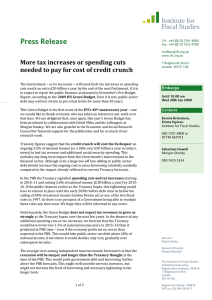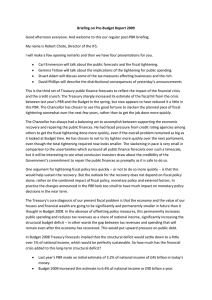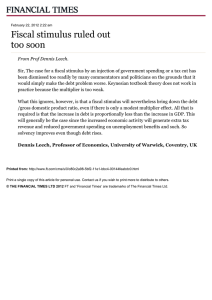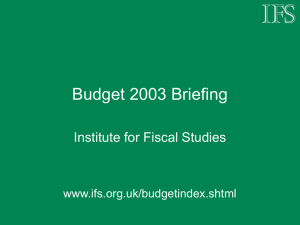B Budg get 2 2009
advertisement
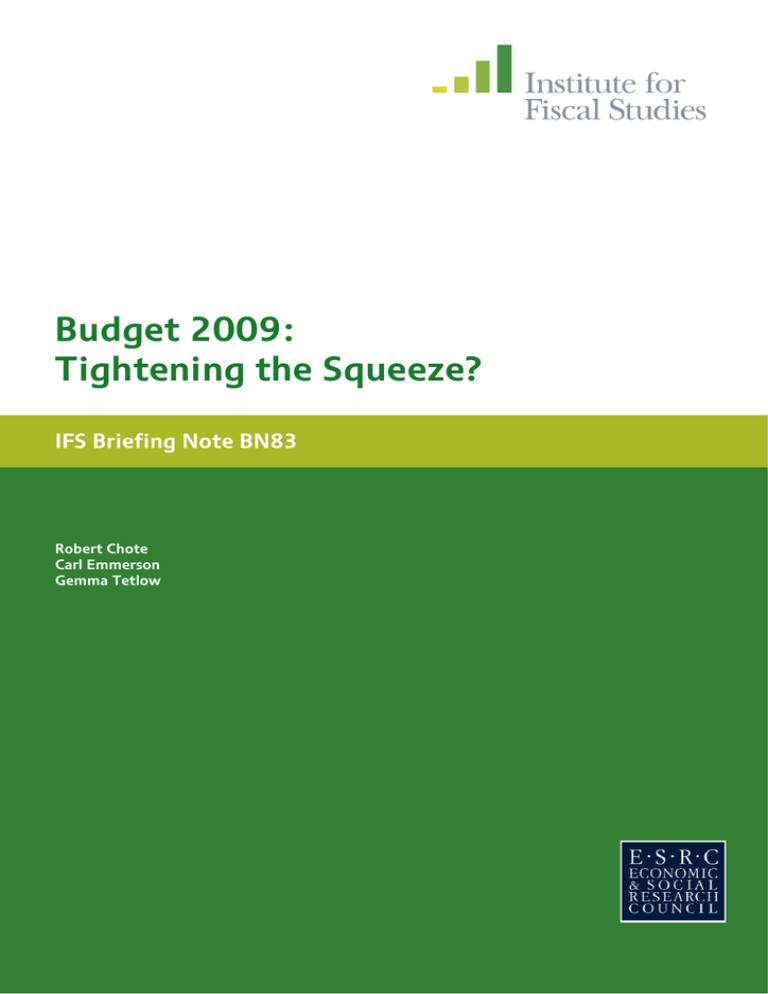
Budg B get 2009 2 9: T tenin Tight ng th he Sq quee eze? IF FS Brieffing No ote BN8 83 Ro obert Chotte Ca arl Emmersson Ge emma Tetlow Budget 2009: tightening the squeeze? Robert Chote, Carl Emmerson and Gemma Tetlow* Institute for Fiscal Studies 1. Introduction The outlook for the public finances appears significantly weaker than the Treasury predicted in the November 2008 Pre-Budget Report (PBR). This will have an important bearing on the two key tax and spending decisions that Chancellor Alistair Darling will have to take in his Budget statement on 22 April: whether to announce an additional short-term stimulus to help support the economy and whether to announce an additional longterm tightening to help repair the public finances. This Briefing Note sets out illustrative projections for the outlook for government borrowing and debt over the next few years. It then assesses by how much this or a future government might need to cut existing public spending plans and/or increase taxes to ensure that the outlook for public sector borrowing was no worse than that laid out in the PBR. The analysis in this Briefing Note builds on the detailed forecasts in the January 2009 IFS Green Budget. It does not re-estimate the Green Budget forecasts, but instead makes some broad-brush adjustments to them to reflect new information and analysis available since the PBR. 2. The outlook for borrowing and debt to 2015–16: an updated baseline In this section, we set out projections for public sector net borrowing and public sector net debt through to 2015–16 and compare them with those implied by the Treasury’s forecasts in the PBR. The projections are built up as follows: • We start with the baseline forecast from the IFS Green Budget, which by construction assumes that the economy performs broadly as expected by the Treasury in the PBR. This forecast shows the government having to borrow 0.5% of national income more than the * Funding from the ESRC Centre for the Microeconomic Analysis of Public Policy (grant no. RES-544-28-5001) at IFS is gratefully acknowledged. 1 © Institute for Fiscal Studies, 2009 PBR expected in 2008–09, rising to 1.5% of national income more in 2015–16.1 This gap largely reflects an expectation that tax revenues would not grow as rapidly as the Treasury hoped, even if the economy performed in line with its PBR predictions. • The recession is now expected – for example, by the Bank of England – to be deeper and longer than the Treasury anticipated in the PBR, which would be expected to depress tax revenues and increase welfare bills. To account for this, we add an estimate of the additional ‘cyclical’ borrowing that the government would need to undertake if economic growth were instead to follow the path predicted in the Bank of England’s February Inflation Report for the next three years, after which we assume that growth accelerates sufficiently rapidly to ensure that the spare capacity in the economy is eliminated by the end of 2014–15.2 We use the Treasury’s traditional rule of thumb, that a 1% loss of national income increases borrowing by 0.5% of national income in year one and 0.2% in year two.3 The growth forecasts and the additional borrowing implied by the difference between them are shown in Table 1. Importantly, this approach assumes that the unexpected depth of the recession does not imply any additional loss of productive potential in the economy – the amount the economy can produce without pushing up inflation – beyond the 4% assumed in the PBR.4 If there were to be, then some of the loss of national income – and the additional borrowing – implied by the Bank’s forecasts would be permanent rather than temporary. 1 See chapter 6 of The IFS Green Budget: January 2009 (http://www.ifs.org.uk/publications/4417). 2 We use the mean of the Bank’s probability distribution for growth, based on the assumption that interest rates move in line with financial market expectations. Source: http://www.bankofengland.co.uk/publications/inflationreport/irprobab.htm. 3 For estimates supporting this rule of thumb, see HM Treasury, Public Finances and the Cycle, November 2008 (http://www.hmtreasury.gov.uk/prebud_pbr08_publicfinances.htm). 4 Paragraph A.58 of HM Treasury, Pre-Budget Report 2008, November 2008 (http://www.hm-treasury.gov.uk/prebud_pbr08_repindex.htm). 2 © Institute for Fiscal Studies, 2009 Table 1. Economic growth and additional cyclical borrowing Economic growth (% year-on-year) Additional public sector net borrowing (% of national income) HM Treasury November 2008 Pre-Budget Report Bank of England February 2009 Inflation Report based scenario 2008–09 –¼ –0.8 0.3 2009–10 –½ –2.9 1.6 2010–11 2 1.7 2.2 2011–12 3 2.5 2.5 2012–13 3 4.1 2.1 2013–14 3 5.1 0.8 2014–15 2½ 3.5 0 2015–16 2½ 2.5 0 • Government borrowing over the first 11 months of 2008–09 is overshooting the Treasury’s PBR forecasts (and those contained in the January 2009 IFS Green Budget) – and to a greater degree than the Treasury’s rule of thumb suggests could be explained by the unexpected severity of the recession. On current trends, the government is likely to have to borrow £95 billion in 2008–09 – some £16.8 billion more than it anticipated in the PBR. Public sector net investment is on course to overshoot the PBR forecast by around £4.3 billion, while revenues are set to undershoot by £12.5 billion. Current (i.e. non-investment) spending is running in line with the PBR forecast, with social security and debt interest spending overshooting the PBR forecasts and other current spending undershooting the forecasts by broadly similar and offsetting amounts.5 We assume that public sector net investment continues on its current trend for the remainder of 2008–09, but that the overshoot does not persist into 2009–10. Of the revenue undershoot, £5.8 billion is explained neither by the Green Budget forecasts nor by the unexpected weakness of economic growth expected by the Bank. We assume that this shortfall persists, implying additional ‘structural’ (or non-cyclical) borrowing of 0.4% of national income each year. 5 For analysis of the monthly public finances figures, see http://www.ifs.org.uk/publications/browse?type=pf. 3 © Institute for Fiscal Studies, 2009 • The additional cyclical and structural borrowing just described would increase the government’s stock of debt more rapidly than implied by the Green Budget baseline alone, which in turn would make it more expensive to service. So we add an estimate of the additional borrowing required to cover the higher debt interest bill. Taking all these factors into account, Table 2 shows projections for public sector net borrowing and public sector net debt as shares of national income through to 2015–16.6 Table 2. Public sector net borrowing and public sector net debt (% of national income) Public sector net borrowing Public sector net debt PreBudget Report Green Budget baseline Extra cyclical Extra structural Extra debt interest New IFS baseline PreBudget Report New IFS baseline 2007–08 2.4a 2.4a n/a n/a n/a 2.4a 36.5a 36.5a 2008–09 5.3 5.8 0.3 0.4 0.0 6.5 41.2 42.3 2009–10 8.0 8.4 1.6 0.4 0.0 10.4 48.2 51.4 2010–11 6.8 7.7 2.2 0.4 0.1 10.5 52.9 59.2 2011–12 5.3 6.4 2.5 0.4 0.2 9.5 55.6 65.3 2012–13 4.1 5.2 2.1 0.4 0.3 8.0 57.1 69.9 2013–14 2.9 4.2 0.8 0.4 0.4 5.8 57.4 72.3 2014–15 2.3 3.7 0.0 0.4 0.4 4.5 56.8 73.1 2015–16 1.8 3.3 0.0 0.4 0.4 4.1 55.7 73.5 a Latest out-turn. The projections show public sector net borrowing at around 10½% of national income in 2009–10 and 2010–11. For comparison, the latest forecast from the International Monetary Fund (IMF) shows UK general government borrowing reaching 9.5% in calendar year 2009 and 11.0% in 2010.7 In cash terms, under our baseline, the budget deficit would be around £150 billion a year in 2009–10, 2010–11 and 2011–12. By 2015– 16, the PBR predicted that the current budget (revenues minus noninvestment spending) would be back in balance and that the public sector would be borrowing 1.8% of national income, entirely to fund investment. Our projections show the current budget still in deficit by 2.3% of national 6 PBR figures for 2014–15 and 2015–16 are estimates by the authors based on the ‘illustrative projections’ published in the PBR. 7 IMF, Global Economic Policies and Prospects, 19 March 2009 (http://www.imf.org/external/np/g20/pdf/031909a.pdf). 4 © Institute for Fiscal Studies, 2009 income in 2015–16, with the public sector borrowing 4.1% of national income in total. The PBR forecast that public sector net debt would peak in 2013–14 at 57.4% of national income and implied that it would have fallen to 55.7% by 2015–16. By contrast, our projections show public sector net debt at 73.5% of national income and still rising (albeit gradually) in 2015–16. We discuss the longer-term outlook for public sector indebtedness in Section 4. 3. The possible impact of financial sector interventions In the discussion so far, we have ignored the impact on the public sector balance sheet of the government’s various investments in UK banks and its other measures to support the financial sector. We did this because the bank nationalisations in particular produce a dramatic short-term increase in the headline measure of public sector net debt, as this measure includes all the liabilities of the nationalised banks but only a relatively small proportion of their assets.8 What matters in terms of the long-term sustainability of the public finances, and therefore the need for any changes to tax and spending decisions, is the size of any profit or loss that the taxpayer will have incurred once these interventions have run their course – for example, once the nationalised banks have been returned to the private sector. The last two IFS Green Budgets (January 2008 and January 2009) have argued that the size of any such profit or loss is very uncertain and we should therefore focus on an underlying measure of debt excluding these interventions until the impact becomes clearer. The eventual profit or loss from the financial interventions remains very uncertain, but we are now seeing more authoritative estimates of the eventual impact, notably from the IMF. It would be prudent for the government to take these into account in judging what measures might be necessary to restore the public finances to health in the longer term, rather than to make the implicit judgement that there will be no net profit or loss. 8 For more details, see pages 94 to 97 in chapter 5 of The IFS Green Budget: January 2009 (http://www.ifs.org.uk/publications/4417). A more recent discussion can be found in IFS analysis of the February 2009 public finance numbers (http://www.ifs.org.uk/pr/pubfin_mar09.pdf). 5 © Institute for Fiscal Studies, 2009 Table 3. Public sector net debt: the impact of financial interventions Public sector net debt (% of national income) New IFS baseline without cost of interventions New IFS baseline with IMF estimate of cost of interventions 2007–08 36.5 36.5 2008–09 42.3 42.3 2009–10 51.4 53.2 2010–11 59.2 62.9 2011–12 65.3 70.8 2012–13 69.9 77.2 2013–14 72.3 81.4 2014–15 73.1 82.1 2015–16 73.5 82.4 In an analysis published on 6 March 2009, the IMF estimated the eventual cost to the taxpayer at 9.1% of national income or around £130 billion.9 At the average interest rate currently paid by the government on its outstanding debt, such an addition to public sector net debt would imply additional debt-servicing payments of around 0.4% of national income at the point the loss is fully incurred. Of course, we cannot be certain whether – or when – such losses would occur, but, in light of the IMF’s prediction, it would seem prudent for the government to consider the implications of such an increase in indebtedness and debt interest payments. In Table 3, we therefore make the illustrative assumption that this increase in debt accumulates steadily over the next five years. The table shows that by 2013–14 public sector net debt would be 81.4% of national income rather than 72.3% (i.e. 9.1% of national income higher). 4. The long-term outlook for debt and debt interest payments The previous two sections illustrate that the outlook for the public finances is significantly weaker than it appeared at the time of the PBR, and more so if the IMF’s long-term costing of the government’s interventions in the financial sector is taken into account (which is not to 9 See table 4 on page 17 of IMF, Companion Paper – The State of Public Finances: Outlook and Medium-Term Policies after the 2008 Crisis, 6 March 2009 (http://www.imf.org/external/np/pp/eng/2009/030609a.pdf). 6 © Institute for Fiscal Studies, 2009 say that the outlook for the economy and the public finances might not have been significantly weaker still had the government not intervened in the financial sector). But what does our analysis suggest about the longerterm path of public sector debt and debt interest payments? To assess this, we assume in Figure 1 that non-debt-interest current spending, investment spending and tax revenues all remain constant as shares of national income beyond the end of the Treasury forecasting horizon, that the trend growth rate of nominal national income is 5¼% a year and that the government continues to be able to borrow at a rate of 4.32% (the average debt interest rate it implicitly forecast for 2013–14 in the PBR). Figure 1 shows that a longer-term projection of the PBR forecasts would see net debt decline gradually, falling back to pre-crisis levels and below Gordon Brown’s long-standing target ceiling of 40% of national income in the early 2030s. Our analysis here suggests that in the absence of a further fiscal tightening, the debt ratio would not peak as the Treasury hopes in 2013–14, but would continue rising for the foreseeable future – rapidly over the next five years and more slowly thereafter. By the early 2050s, net debt would stand at a little below 90% of national income if intervention costs are excluded and a little above 90% of national income if they are included. Figure 1. Long-term public sector net debt profiles Net debt - out-turns PBR forecasts PBR fiscal plans IFS baseline, without intervention cost IFS baseline, with intervention cost 100 80 60 40 20 2050-51 2045-46 2040-41 2035-36 2030-31 2025-26 2020-21 2015-16 2010-11 2005-06 2000-01 1995-96 1990-91 1980-81 1975-76 0 1985-86 Percentage of national income 120 7 © Institute for Fiscal Studies, 2009 Figure 2 shows the long-term outlook for the public sector’s net debt interest payments. The long-term projection of the PBR forecasts imply debt interest payments peaking at 2.5% of national income in 2012–13 and then declining gradually back to pre-crisis levels by the early 2030s. Note that debt interest payments remain well below the peaks of the 1980s and the 1990s because the average interest rate on the government’s outstanding debt stock has fallen from around 10% in the early 1980s to 7% on average in the 1990s to around 4.3% now, where the Treasury expects it to remain for the next few years. Out-turns PBR forecasts PBR fiscal plans IFS baseline (with intervention and 3.32% interest rate) IFS baseline (with intervention and 4.32% interest rate) IFS baseline (with intervention and 5.32% interest rate) 7.0 6.0 5.0 4.0 3.0 2.0 1.0 2050-51 2045-46 2040-41 2035-36 2030-31 2025-26 2020-21 2015-16 2010-11 2005-06 2000-01 1995-96 1990-91 1985-86 1980-81 0.0 1975-76 Percentage of national income Figure 2. Long-term public sector net debt interest profiles If borrowing costs remain at this level, then our baseline projection for public sector net debt (including the costs of the financial interventions) implies debt-servicing costs rising from 1.7% of national income in 2008– 09 to 3.3% in 2012–13 and then to 3.9% by the early 2050s. This would be higher than the peak of the mid-1990s, but still lower than the peak of the early 1980s. If investors take fright at the deteriorating state of the public finances, there is a risk that borrowing costs could rise for the UK government. Figure 2 shows an illustrative projection for the path of debtservicing costs if the average interest rate on outstanding debt were to rise by 1 percentage point by 2015–16.10 Under this assumption, debt10 A recent summary of estimates of the impact of higher debts and deficits on interest rates can be found in section VII of IMF, Companion Paper – The State of Public Finances: Outlook and Medium-Term Policies after the 2008 Crisis, 6 March 2009 (http://www.imf.org/external/np/pp/eng/2009/030609a.pdf). 8 © Institute for Fiscal Studies, 2009 servicing costs would rise to 6.3% of national income by the early 2050s; this would be well above the peak of the early 1980s. If instead borrowing costs were to fall by 1 percentage point, the future burden of debt servicing would be lower, at just 2.3% of national income by 2050 (also shown in Figure 2). 5. Implications for tax and spending decisions in Budget 2009 For most of its time in office, the government claims to have been taking tax and spending decisions consistent with two self-imposed goals: to keep public sector net debt below 40% of national income and to ensure that it borrows only to pay for investment on average over the ups and downs of the economic cycle. The fiscal fallout from the current economic and financial crisis means that, on the Treasury’s own figures, these goals will be missed by huge margins over the economic cycle that the Treasury expects to run from 2006–07 to 2013–14. So in the PBR, the Chancellor set out a ‘temporary operating rule’ committing the government to ensure that the current budget is back in balance and debt falling as a share of national income ‘once the global shocks have worked their way through the economy in full’.11 The PBR forecasts showed these conditions satisfied by 2015–16, two years beyond the end of its normal forecasting horizon. Let us assume that the Chancellor were to agree with the projections outlined in this Briefing Note and that he would still wish to have the current budget on course to be balanced by 2015–16. This would require an additional fiscal tightening worth around 2.7% of national income by 2015–16 (£39 billion in today’s money), on top of the 2.6% of national income (£38 billion) tightening announced in the PBR. Of this tightening, 1.5% of national income would be required to address the revenue undershoot foreseen in the January 2009 IFS Green Budget, 0.4% to address the additional structural borrowing implied by the ‘unexplained’ overshoot in 2008–09, 0.4% to service the immediate debt increases resulting from the financial interventions and 0.4% to cover additional debt interest costs (including those arising from the debt accumulated as a result of the unexpected depth of the recession over the next few years). If such an additional tightening was desired, how might it be achieved? 11 Paragraph 1.13 of HM Treasury, Pre-Budget Report 2008, November 2008 (http://www.hm-treasury.gov.uk/prebud_pbr08_repindex.htm). 9 © Institute for Fiscal Studies, 2009 Figure 3. Options for spending cuts or tax increases under IFS baseline Required tax increase (£ per family, 2009–10 terms) £3,500 Spending constant as share of trend GDP £3,000 £2,500 £2,000 £1,500 No further spending cut £1,000 £500 £0 No further tax rise -£500 -£1,000 -£1,500 -2.0 £25bn tax cut -1.5 -1.0 -0.5 0.0 0.5 1.0 1.5 Change in average annual spending growth from April 2011 to March 2016 The options for spending cuts or tax increases to raise £39 billion in today’s terms are set out in Figure 3. Under the current PBR plans, total public spending is forecast to grow by an average of 1.1% a year, after economy-wide inflation, over the five-year period from April 2011 to March 2016. Given likely increases in debt interest payments and social security spending over this period, the 2009 Green Budget estimated that, to keep total spending growth over this period to just 1.1% a year, total departmental spending on public services might have to be frozen in real terms.12 For £39 billion to be raised without any further tax-raising measures, growth in total public spending over this period would need to be reduced by 1.1 percentage points a year, i.e. there would need to be a five-year real freeze in total public spending. Because of rising real spending on debt interest payments, tax credits and social security benefits, this would require real cuts in most other areas of government spending, and even favoured areas such as health and education would undoubtedly see much lower spending growth than they have received in recent years. Alternatively, were the £39 billion to be raised entirely through further tax-raising measures – thereby eliminating the need for any further spending cuts – then taxes would need to be raised by an average of £1,250 per family. 12 See chapter 9 of The IFS Green Budget: January 2009 (http://www.ifs.org.uk/publications/4417). 10 © Institute for Fiscal Studies, 2009 In addition to the need to ensure the long-term sustainability of the public finances, the government is also thought to be considering whether or not to announce a further short-term fiscal stimulus package to help ameliorate the recession. Leaving aside the issue of its effectiveness, we pointed out in the 2009 Green Budget that the £25 billion two-year stimulus package announced in the PBR would contribute only around one-fifteenth of the increase in public sector indebtedness expected by the Treasury by 2012–13 (i.e. about 1.4% of national income).13 Given the deteriorating outlook for the public finances described above, that stimulus package now makes an even smaller relative contribution to the expected increase in debt. Looking forward, one could argue that with the debt ratio now projected to head towards 90% of national income, rather than peaking at around 57% of national income, any plausible additional stimulus would also be likely to pale into insignificance relative to the underlying weakening of the public finances. Conversely, one could argue that, because debt is going to be so much higher than previously expected, it has become more dangerous to add to it – even relatively modestly. That latter view is consistent with the remarks made by Mervyn King, the Governor of the Bank of England, to the House of Commons Treasury Select Committee, on 24 March 2009: There is no doubt that we are facing very large fiscal deficits over the next two to three years, there can be no doubt about that. I think it is right to accept that when the economy turns down and the automatic stabilisers kick in, so the increased benefit expenditures and lower tax revenues are bound to lead to higher fiscal deficits and it does not make sense to try to offset that so we are going to have to accept for the next two to three years very large fiscal deficits. Given how big those deficits are, I think it would be sensible to be cautious about going further in using discretionary measures to expand the size of those deficits. That is not to rule out targeted and selected measures that may find those areas, whether it is in the labour market, whether it is in corporate credit, that can do some good, but the fiscal position in the UK is not one that would say, “Well, why don’t we just engage in another significant round of fiscal expansion?”. 14 13 See chapter 3, and in particular page 42, of The IFS Green Budget: January 2009 (http://www.ifs.org.uk/publications/4417). 14 http://www.publications.parliament.uk/pa/cm200809/cmselect/cmtreasy/uc376/uc37602.htm. 11 © Institute for Fiscal Studies, 2009 In the 2009 Green Budget, we argued that the decision about whether to announce a second fiscal stimulus package should be taken in the context of a broader decision by the government and the Bank of England regarding the appropriate mix of fiscal measures, further interest rate cuts, ‘quantitative easing’ and additional measures to encourage bank lending. We noted that: If further discretionary fiscal easing were deemed a necessary and desirable part of the mix, then public support for that judgement by the Bank of England would certainly help to reassure people that it was economically rather than politically motivated.15 Given that this support has been publicly and pre-emptively withheld, it would become even more essential for the government to demonstrate convincingly how it proposed to recoup the cost of the stimulus and to address the underlying weakness of the public finances if it decided to defy the Governor’s advice. 6. Conclusion The outlook for the public finances has deteriorated significantly since the PBR, reflecting a variety of factors that are likely to lead to a combination of permanent and temporary additions to the government’s borrowing needs. Illustrative projections of the impact of these factors suggest that in the absence of further cuts in public spending plans and/or tax increases, public sector net debt might soon climb to around 80% of national income (compared with the peak of 57% of national income forecast in the PBR) and continue rising thereafter. If the government still wishes to borrow only what it needs to invest by 2015–16, these projections imply the possible need to announce an additional tightening worth almost £40 billion in today’s money, roughly the same size as the tightening already announced in the PBR. We do not expect the Chancellor to paint as pessimistic a picture as this in the Budget later this month, with a smaller combination of new tightening measures and increases in forecasts for borrowing and debt more likely. But if these projections turned out to be accurate, this would imply the need either for further tightening measures later or for less ambitious goals for the repair of the public finances. 15 Page 128 in chapter 6 of The IFS Green Budget: January 2009 (http://www.ifs.org.uk/publications/4417). 12 © Institute for Fiscal Studies, 2009
